Introduction
In January 2006 Dr. Ahmed Nazif, the then Prime Minister of Egypt, asked Alaa Fahmy, President and CEO of The Egyptian National Telecommunication Regulatory Authority (NTRA) to become the Chairman of the Egypt National Post Organization (EP). Fahmy, with more than 35 years of experience in the telecommunications field and the recent achievement of successfully leading the NTRA for almost 3 years, was no stranger to challenges. After three weeks of thought, Fahmy decided to accept the offer and moved to EP together with his core team.
It was obvious to Fahmy from the start that networking between people was almost non-existent at EP and that there was no standard system in place. A seasoned manager par excellence, Fahmy believed that their success depended on establishing an effective and efficient teamwork even more so than on the need for a standard system.
From this springboard Fahmy came up with his first draft for modernizing EP which rested on three pillars: human resources, infrastructure and, particularly, info-structure as the backbone of the general business processes (refer to Figure1 for a concise illustration of the reform strategy).
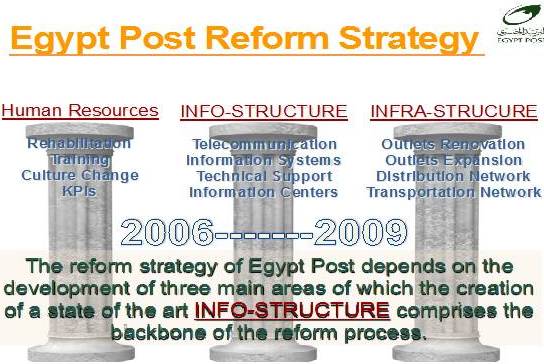
Figure 1: Egypt Post Reform Strategy
It is now acknowledged that no long-term economic growth for EP would have been feasible without including within its folds information and communication technology. In this paper, the researcher attempts to lay out Fahmy’s directives that propelled EP to the forefront, not only in Africa but also worldwide, in such a short-time frame.
Egypt Post Background
EP has the largest and most widely distributed network of outlets in Egypt: 3,700 outlets (Figure 2), 18,000 counters and 45,000 employees (Figure3). Until 2005, EP provided only two types of services: postal and financial.
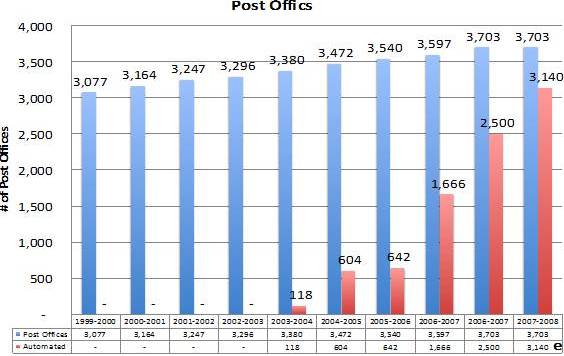
Figure 2: Egypt Post Offices
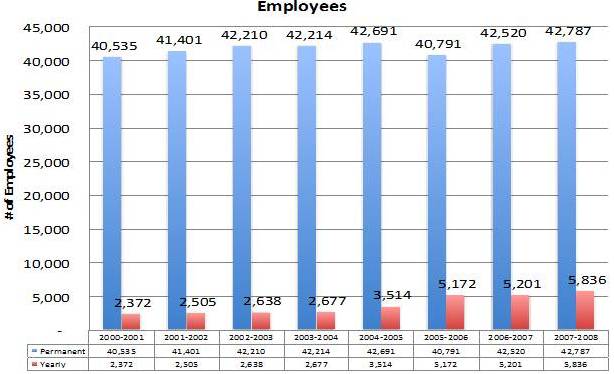
Figure3: Egypt Post Employees
Postal services included normal mail, express mail, registered mail and personal mailboxes. EP handled an average yearly volume of 360 million parcels through 43 sorting centers and 138 distribution centers. However, with the pervasive spread of internet services which had reached some 29 million users in December 2011, with an annual growth rate of 26% across Egypt at that time (ARAB REPUBLIC OF EGYPT, MCIT, 2012), high-speed, broadband internet-based services became practical as well as appealing for many users. In such an environment, the use of online alternatives to mail remarkably increased as postal services witnessed a dramatic decline. As a result, EP’s revenue stream from postal services plummeted to the negative with the industry predicting a further decline in mail volumes in the coming few years.
On the other hand, EP’s financial services dating as far back as 1901 had always had a limited scope. Under Egypt Post Law, EP was not allowed to engage in any lending activity. For many years its financial services were limited to creating and managing saving accounts which gave the highest yearly interest rate in Egypt. Almost 80% of EP’s revenues came from its saving accounts services. In 2005, some 13.5 million clients were using EP’s saving accounts (Figure 4), with a saving volume of LE 46 billion (approximately US$ 8.07 billion)1 (Figure 5). EP’s saving accounts were deposited at the National Investment Bank (NIB)2 with a back-to-back interest rate for the clients and a marginal difference—of less than 1%—which made up EP’s revenue.
1 Calculated according to the average exchange rate in 2006 US$1: LE5.7.
2 The NIB is a state-owned bank acting as a creditor to several government agencies, such as ministries and giant public companies like the Egyptian Railway Authority for example, as well as the business sector at large. At the same time it is a debtor to other entities. The NIB is under the authority of the Ministry of Finance.

Figure 4: Saving Accounts Number of Clients
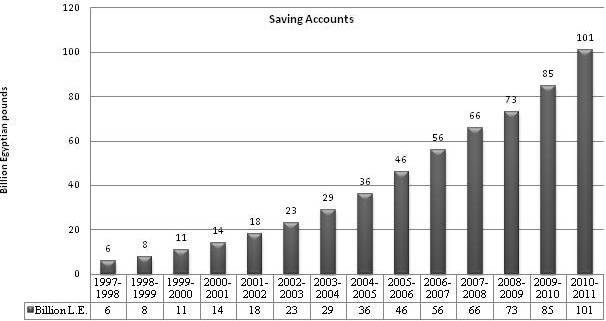
Figure 5: Saving Accounts Volume
Challenges Facing Egypt Post
EP, like all entrenched, centralized bureaucracies faced considerable technical, financial and human-resource challenges. Such challenges become more difficult when attempting to modernize such a sizeable institution without interrupting its daily operations. Moreover, the required transformation would not be possible without resorting to out-of-the-box ideas.
Human resources posed the most obvious challenge. Government institutes— specifically mass employers like EP—generally face a huge problem with illiteracy. However, EP faced problems with illiteracy in the broader sense of the word. EP employees struggled with computer skills and were oblivious to the notions of customer relations and brand loyalty, as well as to the concept of teamwork and vision. With intent to modernize and restructure the business process, tackling this problem of illiteracy was a top priority.
Until 2005, EP did not have a dedicated human resource (HR) department per se, but only a personnel department, which handled basic functions like payroll and bonuses while following the typical bureaucratic hiring processes. Modern HR functions like specialized training, motivation and Balanced Score Cards (BSC) or performance appraisals were non-existent prior to 2005.
The most critical human resource challenge rested with the saving accounts department, where employees (450 staff members at that time) believed they were responsible for generating most of EP’s revenue. Thus, employees of the department believed they were entitled to higher bonuses and special privileges. This belief generated many conflicts with other departments hosting a higher number of employees (for example 30,000 workers in the postal department).
However, contending with the resistance to change of EP’s general employee population was a challenge of a broader scope. The resistance mainly sprang up against new ideas that would change job specifications for many employees, particularly technological or business process changes. Collectively, many employees felt they lacked the necessary skills to cope with such changes, but more specifically, resistance in the saving accounts department sprang from its employees’ fear of losing power with the introduction of new technologies and services.
A final hurdle, yet by no means an easy one, was handling the idle workforce: those employees who contributed little or nothing to the operation. A decision needed to be taken whether to let them go or to direct them to different operations where they would be more productive. Whereas private firms usually opt for firing the redundant workforce (LAGACE, Martha et al., 2001) the Egyptian Labor Law, since its introduction in 1952, makes it extremely difficult, if not impossible, to fire a government employee.
Literature Survey
There is no concrete road map or blueprint for reformation of a postal sector especially in Information and Communication Technology. However, in a research study in the health sector reform in less developed countries by (CASSELS, Andrew, 1995), Cassels mentioned a more coherent approach to health sector. Cassels proposed key institutional components like the state, services providers, resource institutions, institutional purchasers, other sectorial agencies and populations.
Information and Communication Technology (ICT)
In 2005, EP’s ICT info-structure needed a complete overhaul. Briefly, the hardware in use was outdated and unsecure; the telecommunication network was supported by an inferior dial-up infrastructure in the age of super information highways and the network only connected 30 offices out of the 3,800 existing offices; the operations were problematic and erratic; and the department’s personnel were inefficient and untrained.
The ICT department had 500 employees only five of which were actually ICT qualified engineers. The rest of the department’s workforce was computer illiterate and idle, which dramatically reduced the productivity and effectiveness of the department. The challenge was how to upgrade the department and its employees to provide the highly advanced ICT operations and solutions needed for EP’s services especially when EP did not have the facilities and resources for a first class ICT system and its operations.
EP operations involved 3,800 offices, but until the end of 2005 only 604 offices were automated (connected through slow, dial-up, narrowband networks) (Figure 2 ). Furthermore, only 30 out of the 604 offices were actually operational. As such, connections and consecutively services were unreliable and erratic. The ultimate challenge in this category was to connect all 3,800 offices through a reliable connection to ensure consistency of communication and service.
With regard to hardware, EP had only 5 notebooks and 500 outdated PCs that served all EP’s employees. This shortage of computers and their poor quality hindered many operations and prevented the automation of the processes. In addition, EP’s operations server was an outdated NCR system that was practically obsolete and unfit to meet the new technological demands. The main challenge was to build a powerful state-of-the-art server and to install powerful, up-to-date computers to support the automation of approximately 18,000 counters and improve the quality of service.
Even with regards to ICT, the saving accounts department was a special case. In 2005, all the department’s operations depended on one sole application developed 20 years before by NCR. The application was designed as an offline database application because of the lack of connectivity between offices. The offline nature of the application hindered the flow of information and created day-to-day inconveniences for personnel and clients alike. Consequently, clients who opened an account in one office were stuck to that office for further dealings on their account. This lack of flexibility was problematic for clients, and the outdated technique hindered the development of EP.
On the other hand, the Instant Fund Transfer (IFT)3 service was an archaic and outdated system. The money transfer invoice was placed inside a registered letter and sent to the recipient by mail. This lengthy and unsafe process required a complete overhaul. The attempt, in 2004, to automate this service in 30 offices, was just a drop in the ocean. There was a need to automate the entire network for the service to become much more efficient and client-oriented.
3 The IFT is a money transfer service by which individuals could send and receive money across Egyptian governorates without needing to open bank account.
In addition, a small-scale application for IFT was created as a prototype using a small MS-SQL server for the 30 connected offices mentioned above. However, it failed to support even the offices for which it was created. The prototype had several problems, which became evident during high seasons because the system could only deal with a few transactions at a time. Furthermore, troubleshooting system failures during such high seasons was neither efficient nor professional because of this prototype concept, which granted exclusive access to one single person to log in and fix system glitches.
Furthermore, EP’s systems were neither automated nor secured. Since some 85% of all hackers are commonly insiders from within the firm itself (WILSON, Zachary and Poulin, Martin, 2006), tackling the security issue became one of vital importance. The poor tracking systems in place at EP made it almost impossible to track the hackers and a strong security system needed to be implemented, maintained and properly governed.
Additionally, most of EP’s transactions (as well as its financial back office applications like general ledger, payables, receivables, payroll, etc.) were written manually, which constituted an inefficient process with a high margin for error. A vivid example was reporting EP’s yearly financial balance. Because it was done manually, it took more than a year to produce EP’s general balance sheet. Similar problems were faced with budgeting, because previous data was unavailable. Automating these processes was the necessary foundation on which to build the decision support system required to solve budgeting problems as well as others resulting from manual work.
Finally, EP had been following the same internal system procedures since 1954, one that is bureaucratic, ineffective and slow. There was a need to automate the internal system procedures (for example hiring, procurement, et.) in a manner that ensured effectiveness and speed.
Infrastructure and Work Environment
Changing the work environment to a more accommodating and pleasant experience was also another challenge facing EP that entailed redesigning its offices in such a way as to provide a pleasant experience for the customers and employees alike. The headquarters also needed to be remodeled to encourage and stimulate employees into becoming more productive. While it may appear as a minor challenge, the impact it would have on employees, customer satisfaction and brand equity justifies its importance (Figure 6).
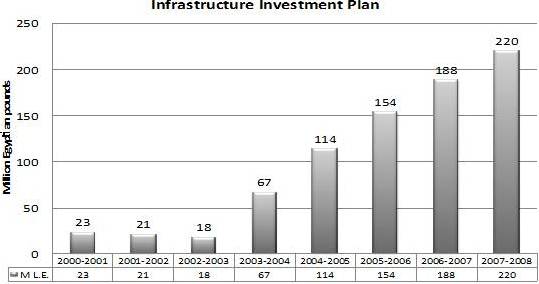
Figure 6: Infrastructure Investment
EP Reform Strategy
EP’s reform started with its mission statement “To provide every household, and business entity (including government) across Egypt with the ability to communicate and conduct business with each other and the world through prompt, reliable, secure and economical services for the collection, transmission, and delivery of messages, forms, money and merchandise.” The vision, strategies, objectives and initiatives are outlined in EP’s strategy document written in October 2003 and approved by Dr. Nazif (at that time the Minister of Communication and & Information Technology) (UNDP, 2005). Taking those as a starting point, Fahmy embarked on a strategy to reform EP and catapult it into the 21st century. (Figure 1) illustrates his strategy, which rests on three pillars: human resources, info-structure and infrastructure.
To sustain the main pillars of the reform strategy, two extra support sectors were created: services development, and investment and economic studies.
As mentioned briefly above, until 2005 EP mainly offered two services: postal and financial. The postal services accrued huge loses while the financial services—split between saving accounts and IFT—generated some revenue for EP. The funds from the saving accounts were routinely deposited in the NIB at 10% interest rate on average at that time. EP clients earned a 9% interest on their deposits while EP retained 1% of that interest as revenue.
With a plan to absorb the idle staff through expanding the portfolio of services offered by EP, a services development sector was created to see this plan through. The mission of the new department was twofold: to develop new revenue generating services to reduce the sole dependency on saving accounts and to use the idle staff through relocating them to the new departments. This was an alternative approach to downsizing to cut losses; in fact this approach was expected to increase revenues and provide more job opportunities in due time.
Between 2006 and 2010, thirteen new services were developed beside the postal and financial services. For example, these services included Portable Post Offices that were relocated to areas of seasonal high demand throughout the year (Figure 8: Portable Post Office). Another service was the EP investment scheme (an investment portfolio that blends high and medium risk investment with risk investments). Additionally, pension distribution and pension-to-home delivery services were introduced. Furthermore, EP provided coordinating services between end users and service providers (like Egypt air for example), as well as bill payment services (for a complete list of new services refer to Figure 7).
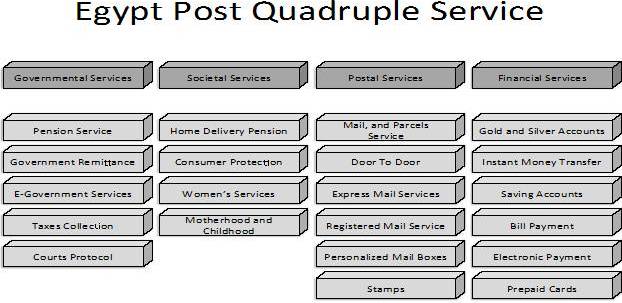
Figure 7: Egypt Post Quadruple Service
Until 2006, EP depended on the saving accounts and consequently on the NIB to invest its considerable fund. Depending on one source for returns is never a solid financial idea for any institute and even more so for one the size of EP. To diversify the sources, an investment committee was created to guide future investments. The board for this committee created and managed several portfolios with variable risk/return investment (high, medium and low). This diversification guaranteed an average return on investment of almost 12%, which is 3% over the interest rate provided by the NIB.
After setting up the two new divisions, Fahmy introduced an organization structure that would help him achieve EP’s objectives and it proposed seven vice chairmen for EP to steer the major divisions of the organization. After selecting his vice chairmen, Fahmy then coordinated with them to build the supporting functions for their divisions and the hierarchical employee support structure—the managers and middle managers of EP (Figure 8).
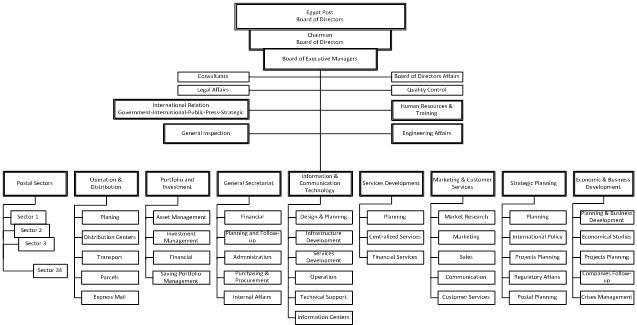
Figure 8: Egypt Post Organization Structure
The final issue that concerned Fahmy was how to tie the net monthly salary of each employee with his performance according to EP’s Key Performance Indicators (KPIs) (KAPLAN, Robert and Norton, David, 2000)). Fahmy set out to classify EP’s offices into three categories—A, B and C. His criterion was based on a combination of factors: number of clients, revenue, size (number of counters), geographical location, etc. Following that, each category received an individual set of KPIs which included, but was not limited to, the number of new clients, rate per service, profit rate and customer satisfaction. Fahmy set a three-month trial period to test and fine-tune the indicators for each category. However, Fahmy understood that EP employees needed intensive soft-skills courses if they were to meet the standards set by the organization’s KPIs. He thus initiated intensive training courses, particularly for employees who interfaced with the customers (Figure 9), with the biggest training budget ever witnessed by EP. Within six months customer satisfaction increased, saving accounts were on the rise, other services were satisfactory, and employees were awarded based on their performance.
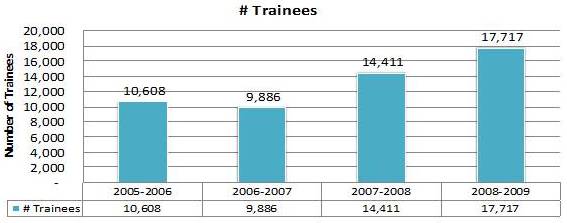
Figure 9: Number of Trainees
Fahmy categorized EP’s KPIs into four categories (Figure 10): employees’ satisfaction, consumer satisfaction, service development program and economic development.

Figure 10: Egypt Post Key Performance Indicators Categories
Employees’ satisfaction significantly increased throughout the lifespan of EP’s modernization process, and this can be gauged by the increase in average wages and revenues per employee (Figure 11), the significant investing in infrastructure (Figure 6) and the number of employees that benefited from training courses proffered by EP (Figure 9).

Figure 11: Avge Wage-Avge Revenue / Employee
Consumer satisfaction also rose in parallel and is reflected in the increased use of EP services especially the IFT service in terms of number of transactions (Figure 12) and volume or value (Figure 13).

Figure 12: Instant Fund Transfer (Transactions)
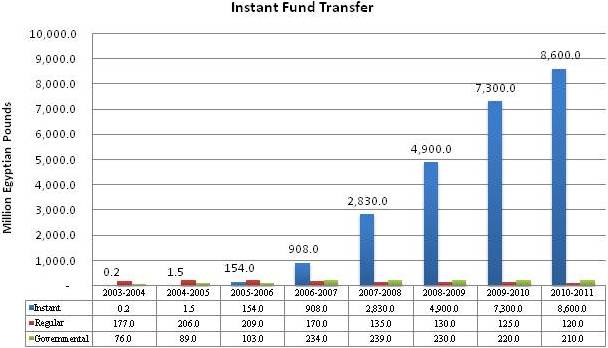
Figure 13: Instant Fund Transfer (Volume)
The pension service also reflected customer satisfaction in terms of volume and value (Figure 14).

Figure 14: Pension Service (Transactions-Volume)
Meanwhile, the KPI concerned with the economic development of the organization in general is reflected in EP’s net profit and return on investment (illustrated in Figure 15 and Figure 16, respectively).
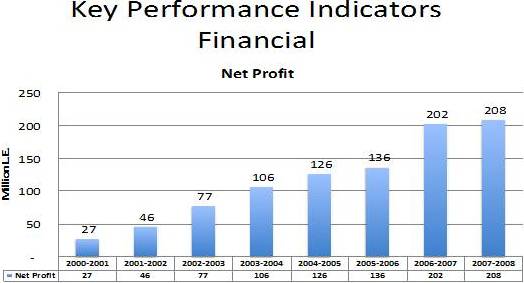
Figure 15: Egypt Post Net Profit

Figure 16: Return on Investment
ICT Strategy Plan
Since all the new services developed by the services development sector rested on ICT, the information and communication technology strategy was essential for modernizing and reforming EP. To this end, Vice President for Information and Communication Technology Amr Badr El Din worked on a comprehensive plan to upgrade EP’s technology.
After three months, Badr El Din presented to the high executive committee chaired by Fahmy his three-year, LE300 million (approximately US$ 52.6 million) ICT strategy plan. Starting with the vision and mission of the ICT department all the way to objectives, goals, tasks and KPIs for every employee, the strategy included a time frame and assigned responsibilities for every task. Whereas Fahmy approved the strategy and the budget, he adamantly refused the three-year period and gave Badr El Din nine months to one year for implementation.
Badr El Din’s plan was based on the divide-and-conquer strategy. First, he divided the ICT components into three main chunks: core, edge and access. He further divided the core component into three: digital communications, server farm and data center and security and operations center. The access component was also divided into three: core applications such as Enterprise Resources Planning (ERP), services such as the postal service and user applications such as those used at point of sale. Finally, the access component was further divided into two: data marts and On Line Analytical Processing (OLAP) (see Figure17 for an illustration of the model).

Figure 17: Information and Communication Strategy Plan
These seven sub-components represented the total ICT problem and later, the divide-and-conquer approach was again used to split them into pieces that are more manageable. The multitude of complicated tasks that need to be implemented to form a modern ICT system makes forming such a system quite a large and complex task. The internal structure plays an integral role not only during the design and implementation phases, but also through the entire life of the project. A solid ICT structure essentially allows for modifications and enhancements for easier implementation without affecting other components.
Since the ICT system is comprised of more than one component, the interoperability of these components is very important to guarantee the execution of the vision. (DZEMYDIENE, Dale et al., 2008) define Interoperability as “the capability to communicate, execute programs or transfer data among various functional units in a manner that requires the user to have little or no knowledge of the unique characteristics of those units”. As interoperability can be examined in different aspects in terms of framework whether physical, empirical, social and so on, there are several ways that could be used to make all the components blend. When designing ICT components, careful thoughts and effort should be considered to ensure the interoperability between the components (DZEMYDIENE, Dale et al., 2008), (TINEKE, Egyedi M., 2007), because standard-compliant products do not always interoperate. It is a frustrating problem, and sometimes drastic measures are taken to circumvent it.
The ultimate purpose is to ensure the execution of the end functions for which this system was initially built to deliver and to do that, four approaches were considered: Monolithic Approach, Hierarchical Approach (SLOAN, Alfred, 1975), Object-Oriented Approach (JACOBOSON, Ivar et al., 1992), and Service-Oriented Approach (ERL, Thomas, 2009), (ERL, Thomas, 2012). Finally the hierarchical approach was selected. In what follows the researcher will examine briefly the various possible information and communication technology components structure.
Monolithic Approach: The most primitive approach for designing any ICT system components is the monolithic approach. The system components may be viewed as modules, functions or procedures that communicate together or call each other without any restrictions. The structure is that simply there is no structure (STANKOV, Ivan and Spasov, Grisha, 2006). In this approach, modification and debugging is a hectic job since the designer has to go through the complete system, reading and understanding each procedure or module during modification or debugging. To cope with the modern requirements of ICT components, the monolithic approach must be rejected.
Hierarchical Approach: (SLOAN, Alfred, 1975). The basic idea behind this approach is that ICT system components can be ordered in layers. Each layer represents some ICT components. When layers are structured in a hierarchical manner, the bottom layer represents the infrastructure components while higher layers represent the interface components. The only constraint in such a design is that components in higher layers can only use services provided by components in lower layers but not vise-versa.
Although this restriction makes designing the ICT components initially complicated, it proves easier to debug, modify and enhance throughout the entire lifetime of the system.
Object-oriented Approach: (JACOBOSON, Ivar et al., 1992). In this approach, the ICT components can be viewed as a collection of objects. A digital communication network is one object but other possible types may include Local Area Network (LAN), Wide Area Network (WAN), applications, ERP and a variety of other components. Each object contains a set of messages that define the operations applicable to that specific object. The resulting structure of an object-oriented system is a network of separate objects communicating with messages.
Service-oriented Approach: (ERL, Thomas, 2009), (ERL, Thomas, 2012). Service-orientation is a design paradigm comprised of a specific set of design principles. The most fundamental unit of service-oriented solution logic is the service. Services exist as an independent program with specific characteristics. Each service is assigned its own distinct functional context and is comprised of a set of capabilities related to this context. Those capabilities suitable for invocation by external consumer programs are commonly expressed via a published service contract. A service composition is a coordinated aggregate of services. A composition of services is comparable to a traditional application in that its functional scope is usually associated with the automation of a parent business process. A service inventory is an independently standardized and governed collection of complementary services within a boundary that represents an enterprise or a meaningful segment of an enterprise. An IT enterprise may include a service inventory that represents the extent to which SOA has been adopted. Service inventories are typically created through top-down delivery processes that result in the definition of service inventory blueprints. The service-oriented approach is considered one of the most modern and sophisticated methods of actions. However, in 2005, this method still needed to be validated and thus was too new to use for a huge organization like EP.
Implementation of the ICT Strategy
Badr El Din started by constructing an ICT organization structure that would help him achieve his targets. Badr El Din decided to base his organization structure on the System Development Life Cycle (SDLC). The SDLC is a process of creating or altering information systems (Wikipedia). The basic model of SDLC comprises systems analysis, systems design, implementation and testing, acceptance and deployment and maintenance. EP’s ICT organization structure reflects the SDLC methodology (Figure 18).
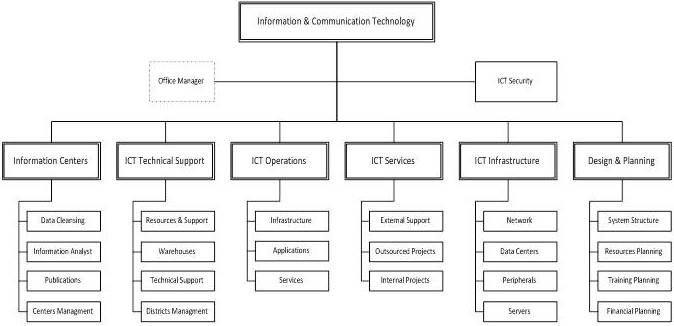
Figure 18: Information and Communication Technology Organization Structure
The structure includes first the design and planning sector, which reflects the system analysis and design, second the ICT infrastructure and services, which reflects the implementation phase, and third the operations and technical support which reflects the testing, acceptance, deployment and maintenance functions. In addition, Badr El Din included the information centers sector to provide end users with automated, state-of-the-art solutions to support access to information and decision-making. This step was essential as a supporting function that easily compiled reports for individual users across departments and in turn helped all the departments to meet their respective objectives.
EP’s ICT plan is based on a hierarchical layered model consisting of the seven layers mentioned above (Figure 17). Such hierarchical designs have proven easier to debug, modify and implement. However, choosing which functions to be placed at which layers requires careful thought, since restrictions often are imposed in such designs that only allow downward calls. The chosen functions would necessarily reflect not only the needs of the ICT department, but also those of the organization.
On the design front, the network consisted of 3,700 broadband communication links in addition to 2,800 narrow band links for backup (Figure 19).
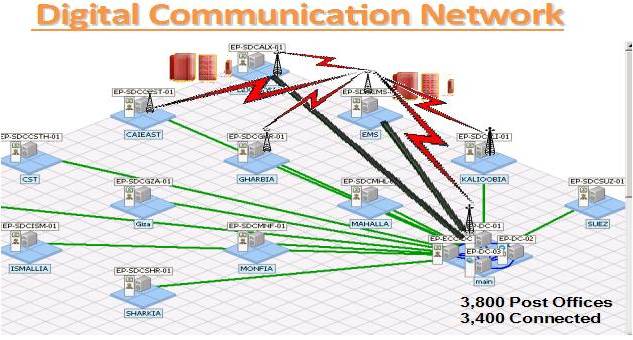
Figure 19: Digital Communication Network
Designing such network is technically a straightforward task; however, implementing such network in one year is quite a challenge. Resorting to out-of-the box solutions was now necessary to meet the advancing deadline.
A regular Request for Proposal (RFP) was issued to Internet Service Providers (ISPs) to bid for the tender. However, since the project was quite a big one in terms of investment, volume and coverage, both vertically and horizontally, the team responsible for issuing the RFP was composed of EP and the Ministry of Communication and Information Technology (MICT) found that it would be a difficult task to accomplish within the required period of nine months. It was also not economically feasible for one single ISP to bid for the whole project. To move things along, EP’s ICT department together with MCIT’s network department decided to allow all seven ISPs to each take a part in implementing the network. Five months later EP announced the bid winners and started the implementation phase. Yet the next obstacle was how to get the telecommunication services up and running in 3,700 offices in just six months. The pressure was compounded by the fact that available EP employees in the ICT department were mostly computer illiterate and thus incapable of operating the system and its services.
To circumvent this hurdle, Fahmy and Badr El Din decided to start the biggest internship program the country has ever seen. They decided to bring in undergraduates from engineering and computer science majors from the American University in Cairo (AUC), the German University in Cairo (GUC), and Cairo, Mansoura, Alexandria and Ain Shams Universities to help install computers and train employees on applications in the offices. Within a week, Badr El Din started meeting some 600 students to discuss the internship roadmap for the three months of the summer holiday to come. Meanwhile, ICT department employees were used to liaise between the students and the offices for which they would be responsible in logistical and administration matters. The students were then divided into groups of 70 to attend three-hour training courses to prepare them for the task ahead. Concerning compensation for students it was decided that all interns would get allowances for accommodation and transport. However, it was also decided that interns would get bonuses on each individual job completed successfully. This entailed setting up a computer, installing its applications and successfully training an EP employee to perform a service transaction using the installed software.
In a week’s time 600 students were sent all over the country and 70 of EP’s ICT department were working round the clock over the phone to provide help. Three months later, 2,800 offices were operational. Not only was this internship program effective in getting the job done but it also proved invaluable for the interns, the ICT department and EP in general. The idle staff that previously had inadequate and incompatible talent became effective in handling a multitude of tasks and the interns with their proficiency and specialization saw a place for themselves in EP.
Server farm and Data Center
The second task for Badr El Din was the server farm and data center. In 2006, EP neither had a proper hardware server to host the required volume of transaction and data nor the proper place to host that server. Badr El Din knew that when the network was up and ready the millions of transactions expected to flood through it would definitely crash the old servers.
He immediately initialed two IT teams to explore with multi-national companies specialized in hardware solutions the best possible options for hardware servers and places to host them. Replacing the obsolete NCR server that provided neither backup nor redundancy became a priority for the smooth running of the saving accounts department. In parallel, it was necessary to replace the server that hosted the IFT transactions, which crashed during high seasons and forced employees to resort to the manual system. (Figure 20) shows the structural design for the required hardware, while (Figure 21) shows the actual hardware including the storage and the backup tape library.

Figure 20: Required Hardware Servers
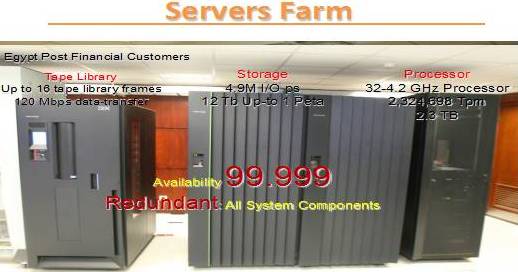
Figure 21: Actual Hardware Servers
The installed hardware is considered the biggest hardware in Egypt in this category in terms of its processing power, storage and technology.
It was also crucial to install security measures against hackers for such a big organization as EP for which, until that time, the concept of a security system had ceased to exist.
Software applications operation and technology were also another major challenge. Only three in-house development applications were being run, maintained and developed by the 20-person IT department’s self-study programmers. The first application which served the saving accounts department used NCR hardware and software. NCR is a long forgotten company with products that are now considered obsolete, and its systems cannot reliably serve millions of saving accounts. The second software used by the IFT department was run on Access database with a visual basic interface. Meanwhile, the third software installed for the Current Account Daily Interest Service (the gold and silver services) used an SQL database with Intel hardware. Such an environment created a conflict for EP operations and clients alike and resulted in the inconsistency of EP services. This meant that if a client needed to use all three services, he/she had to stand in three different queues, present an ID card to three different employees and all for services provided by the same entity. The inconsistent and time-consuming service made the clients’ experience inside EP an extremely unpleasant one. Finally, in development or trial was a relatively reliable system, which was used for EP debit cards. The system used IBM software through DB2 as well as hardware, which were installed in 2007. This service had just started and it was for ATM cards implemented by IBM in terms of hardware, software and even operations. However, at that point in time it only operated 50,000 ATM cards and 40 ATM machines.
Badr El Din’s long-term solution for EP applications was based on three waves as illustrated in Figure 22).
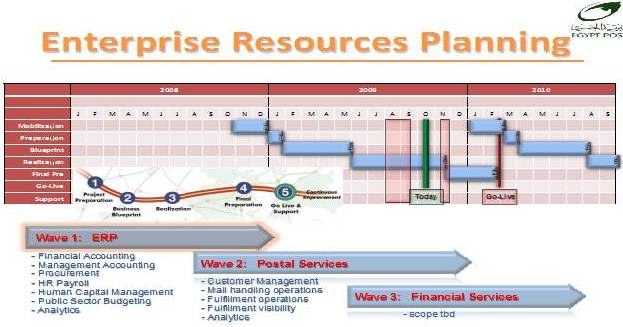
Figure 22: EP Applications Plan
However, concerning software applications, a special Board of Directors meeting endorsed Badr El Din’s decision to consolidate all applications under one system—that of IBM—as a short-term solution and a quick fix until the final system was in place. Among all other systems and applications, IBM’s packages seemed to be the most reliable and befitting all of the services offered by EP at that time. This decision created, for the first time in the history of EP, the concept of the universal counter—one counter that provided all the services offered by EP. Although this was tendered as a short-term solution, the board also saw this as a chance to test the capabilities of the system on the ground. If it proved effective, it could be converted into the long-term solution, as there were other challenges to tackle.
By that time in 2006, EP’s Smart Village headquarters was almost finished. On a thought, Badr El Din asked Fahmy to host the server farm and data center at headquarters in place of the EP Museum, which was slated a spot in the building. Fahmy supported the idea wholeheartedly and moved the museum to another nearby location. Within three months, the space was ready to host the hardware servers (Figure 21 and Figure 23).
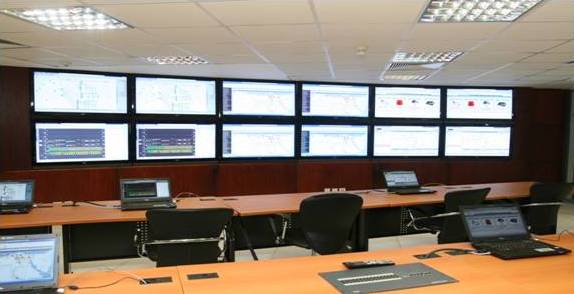
Figure 23: Network Operation and Monitoring Center
In mid-2006, EP’s ICT security department signed a memorandum of understanding (MoU) with the National Security Agency to help build phase one (costing US$2 million) of the security prerequisites (or infrastructure) for EP’s financial and transactions database.
In addition, Badr El Din’s plan also involved using article 15 of the Egyptian Postal Law (Egypt Post law 19, Year 1982) which gives EP the right to create on its own, or with others, companies to serve EP’s objectives. Back in 1982, this specific privilege was only given to two government entities, EP and Egypt National Railway.
Both the Prime Minister and the Minister of Information and Communication Technology supported this Public-Private Partnership (PPP) concept for EP and together Fahmy and Badr El Din sent a request for information (RFI) to several multinationals to join EP in forming an Egyptian company whose topmost priority was to serve EP.
All the giant companies—IBM, Oracle, Microsoft and SAP— showed interested in the RFI. The internal committee at EP concluded that SAP was the most suitable candidate because of its experience in the postal industry. Fahmy also had a similar line of thought but in addition, he wanted to use SAP as a business process re-engineering company and not as just an IT applications company. SAP, although surprised, proposed a consortium of EP and SAP Arabia (SAP’s arm and liaison for operations in the Middle East), to be supported by SAP AG, Germany when necessary. However, Fahmy refused this business model. He wanted SAP AG itself to be committed to the project and not in just a supporting role, and he asked his team to negotiate this with the headquarters in Germany.
SAP HQ approved the joint company named Post for Systems (PFS). The established company’s initial scope of work was to implement the ERP System, the Postal System and the Banking System for EP over a four-year period. According to EP’s agenda, priority was given to the ERP system since it was the most needed at that time. After successful implementation, the project would proceed to find the adequate ICT solutions for the Postal System and then the Banking System. However, PFS’s scope goes beyond the EP implementation plan. The plan for this company was to create ICT solutions for other companies, thus becoming a revenue generator for EP.
Another added benefit for unifying the system under SAP was the ease of generating reports to support the decision making process. Previously when there were many systems, there was no option other than the old fashioned reporting system and analysis tools to compile reports. This was time-consuming and inaccurate in many ways and there was a dire need for a strong professional data warehouse tool to encapsulate all databases into one. Once this structure is in place, an OLAP tool would be connected to generate thousands of reports, graphs and charts at the touch of a button. The variety of ready-made scorecards, dashboards and multidimensional analysis formats would give decision makers the opportunity to take decisions without being technically involved in the operation itself (Figure 24).
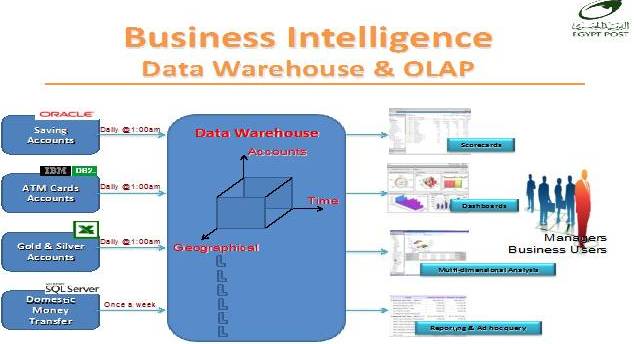
Figure 24: Business Intelligence Model
Conclusion
This paper case details how the ICT component was crucial in turning around EP from a typical outdated, bureaucratic, public-sector giant to a modern organization, which can easily navigate the pressures and the competition of the 21stcentury.
The change that took place in such a relatively short period of time was phenomenal. EP went from a company facing considerable technical, financial and human resource challenges to a technologically modern, customer-oriented and financially effective entity with capable management and well-trained employees. The steady rise in key performance indicators, whether financial like net profit and return on investment, or service-related like volume and value of services transactions in addition to the investment in infrastructure and employees, is a clear indication of the headway that the company has made since the commencement of its modernization process.
However, the great strides that have taken place at EP are just the beginning of a greater transformation that is expected to continue in the future.
Despite the exceptional success of EP’s ICT sector in transforming the financial services of EP and propelling the company into a very different league, this is just the first step. To follow is the automation of EP’s second arm: the postal services. However, the great strides (in the work environment, automation, vertical and horizontal coverage, agreement with SAP, trained personnel, network, server farms, etc.) have definitely paved the road for a smoother transition for automating the postal services also through using SAP applications. PFS, now considered one of the most successful public private partnerships in Egypt, is ready to start the implementation phase of automating the postal services.
At the same time, EP’s success has prodded many countries around the world, but especially countries in the African continent, to seek out EP’s help with ICT services. Furthermore, several European countries have negotiated, and some have established partnerships with EP to provide EP services in their countries and vice versa. With the current ICT model run by EP, the systems for the offices were successfully tested and automated in one week. To date, EP has signed six Memorandums of Understanding (MoU) with European and Arab countries, which now provide EP services to their national customers.
By all measures be it internal indicators or external recognition and acclaim, EP is a success case to be analyzed.
Acknowledgments
I would like to thank H.E.Eng.Alaa Fahmy Minister of Transport (2010-2011), and Chairman of Egypt Post (2006-2010). In addition, I want to thank Dr.Sherif Kamel Dean of the School of Business, The American University in Cairo.
I would also like to extend my appreciation to Nadine El Sherif for providing editorial assistance and beneficial suggestions. Furthermore, I would like to thank Farah Shurab for many fruitful discussions and comments.
(adsbygoogle = window.adsbygoogle || []).push({});
References
Arab Republic of Egypt, Mcit. (2012). Ict Indicators in Brief.
Publisher
Christerson, M., Jacobson, I. & Constantine, L. L. (1992). Object-Oriented Software Engineering. Addison-Wesley.
Publisher – Google Scholar
Donovan, J. J. & Jacoby, H. D. (1975). A Hierarchical Approach to Information System Design. Center for Information Systems Research.
Publisher – Google Scholar
Dzemydiene, D., Maskeliunas, S. & Dzemyda, I. (2008). “Interoperability of Information System Components for Monitoring of Sewage and Intelligent Analysis of Water Resources,” Baltic Journal on Sustainability. 14(3), Pp.260-278.
Publisher – Google Scholar
Egyedi, T. M. (2007). Standard-Compliant, but Incompatible?!
Publisher – Google Scholar
ERL, Thomas. (2009). What is SOA? [online]. Available from World Wide Web: www.whatissoa.com
Publisher
ERL, Thomas. (2012). What is SOA?-An Introduction to Service-Oriented Computing. [online]. Available from World Wide Web: http://www.whatissoa.com/p16.php
Publisher
Kaplan, R. S. & Norton, D. P. (2000). The Strategy-Focused Organization: How Balanced Scorecard Companies Thhrive in the New Business Environment. Harvard Business School Publishing Corporation.
Publisher – Google Scholar – British Library Direct
Lagace, M. & Writer, S. Hbs Working Knowledge. (2001). Jack Welch Class Day Interview-Jack Welch to HBS Grads: “Don’t be a Jerk”. [online]. Available from World Wide Web: <hbswk/hbs.edu/archive/2310.html>
Publisher
Stankov, I. & Spasov, G. (2006). Discussion of Microkernel and Monolithic Kernel Approaches. In: International Scientific Conference Computer Science.
Publisher – Google Scholar
UNDP. (2005). Support to Modernization of Egypt Post, Including Improved Access for Citizens.
Publisher
Wilson, Z. & Poulin, M. (2006). Hacking: The Basics.
Publisher


























